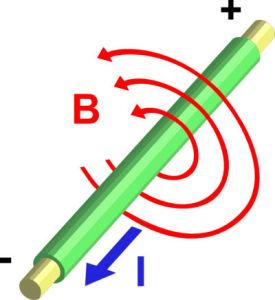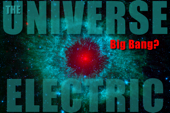The Simplified Case for Cosmic Electrodynamics
06/30/08
Astronomers have implicated a strong role for magnetic fields in many astrophysical processes, yet they appear to be at a loss to explain those magnetic fields or why they should be important. Working within a gravity-dominated paradigm does not help the situation either.
In a recent exegesis submitted to the citizen-powered news site Now Public, a case was made for considering the role of electrodynamics (the movement of charged particles) in astronomy and cosmology. Herein that case is to be made simpler.
The essence of the issue lies in the treatment of magnetic fields by astronomers without reference to any treatment of the underlying electric currents. This seems to be in part due to their use of "new physics" du jour "frozen-in field lines" in plasma and "magnetic reconnection".
Simply put, those concepts may be (and likely are) erroneous.

Electric current produces a magnetic field. The magnetic field can be visualized as a pattern of circular field lines surrounding the [conductor].
Image Credit: Wikipedia / User:Wapcaplet / User:Stannered
Nobel prize-winning plasma physicist (and "father of magnetohydrodynamics") Hannes Alfvén has strongly argued against both the "frozen-in field lines" concept (which he more-or-less invented and popularized before realizing he was in error and imploring astronomers and physicists to ignore his incorrect pseudopedagogical concept) and the concept of "magnetic reconnection" (which he simply referred to as pseudo-science). His thoughts are summarized in one or more peer-reviewed paper(s) he has written on the subject.
More recently, Don Scott has published a peer-reviewed paper also refuting "magnetic reconnection".
If Alfvén and Scott are correct and these two concepts are incorrect, what are we then left with? As it should be, we are left with little more than the definitions of magnetic fields and electric currents as well as the relationship between the two.
A brief survey of definitions turns up several sites in relative agreement.
The HyperPhysics site defines magnetic fields thus:
Magnetic fields are produced by electric currents , which can be macroscopic currents in wires, or microscopic currents associated with electrons in atomic orbits.
One of NASAs educational web sites offers the following about magnetic fields:
People not familiar with magnetism often view it as a somewhat mysterious property of specially treated iron or steel.
[
]
It is all related to electricity.
[
]
Close to 1800 it was found that when the ends of a chemical "battery" were connected by a metal wire, a steady stream of electric charges flowed in that wire and heated it. That flow became known as an electric current. In a simplified view, what happens is that electrons hop from atom to atom in the metal.
In 1821 Hans Christian Oersted in Denmark found, unexpectedly, that such an electric current caused a compass needle to move. An electric current produced a magnetic force!
Andre-Marie Ampere in France soon unraveled the meaning. The fundamental nature of magnetism was not associated with magnetic poles or iron magnets, but with electric currents. The magnetic force was basically a force between electric currents (figure below):
--Two parallel currents in the same direction attract each other.
--Two parallel currents in opposite directions repel each other.
[
]
--Two circular currents in the same direction attract each other.
--Two circular currents in opposite directions repel each other.
The World Health Organization defines the electromagnetic field thus:
Electric fields are created by differences in voltage: the higher the voltage, the stronger will be the resultant field. Magnetic fields are created when electric current flows: the greater the current, the stronger the magnetic field. An electric field will exist even when there is no current flowing. If current does flow, the strength of the magnetic field will vary with power consumption but the electric field strength will be constant.
- Electromagnetic fields published by the WHO Regional Office for Europe in 1999 (Local authorities, health and environment briefing pamphlet series; 32).
[Italics added.]
Wikipedia defines the electromagnetic field thus:
The electromagnetic field is a physical field produced by electrically charged objects. It affects the behavior of charged objects in the vicinity of the field.
[
]
The field can be viewed as the combination of an electric field and a magnetic field. The electric field is produced by stationary charges, and the magnetic field by moving charges (currents); these two are often described as the sources of the field. The way in which charges and currents interact with the electromagnetic field is described by Maxwell's equations and the Lorentz force law.
The definitions appear to be quite explicit.
The electric field is derived from the collective stationary charges on one or more charged particles themselves (electrostatics).
The magnetic field is derived from the motion of charged particles in an electric current (electrodynamics).
From the definitions it appears to proceed logically that, due to the relationship between electric currents and magnetism, we should be able to work backwards or forwards depending on what we observe.
In fact, the Wikipedia article on electric current states:
Electric current produces a magnetic field. The magnetic field can be visualized as a pattern of circular field lines surrounding the wire.
Electric current can be directly measured with a galvanometer, but this method involves breaking the circuit, which is sometimes inconvenient. Current can also be measured without breaking the circuit by detecting the magnetic field associated with the current.
[Emphasis added]
If we observe an electric current, we should understand that a magnetic field is generated proportional to the strength of the current. Likewise, where we see a magnetic field we should understand that it derives from the underlying motion of charged particles and that its strength derives from the strength of the underlying current.
The implications are simple yet far-reaching.
Magnetic fields have been strongly implicated in everything from star formation to black holes jets, the structure and evolution of galaxies and galaxy clusters.
If magnetic fields are held at least partially responsible for the structure and function of the universe, then by extension electric currents are equally important in the structure and function of the universe. If the universe and galaxies are threaded by magnetic fields, then they are equally threaded by the electric currents from which the magnetic fields arise.
If that be so, then the universe in which we live is truly electric.
Michael Gmirkin
Permalink to this article.
Public comment may be made on this article on the
Thunderbolts Forum/Thunderblogs (free membership required).
|





